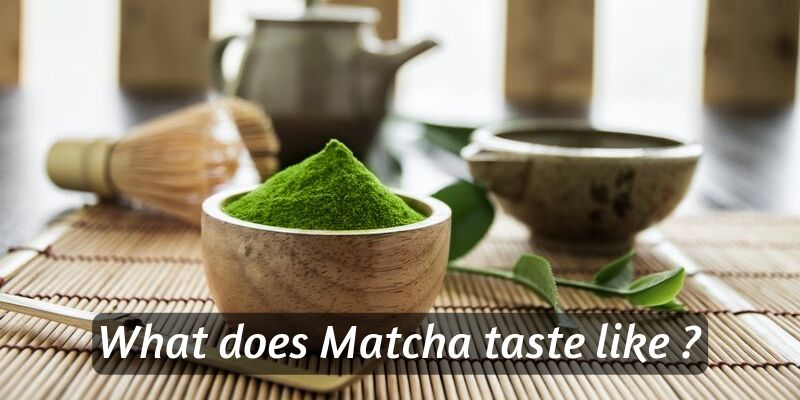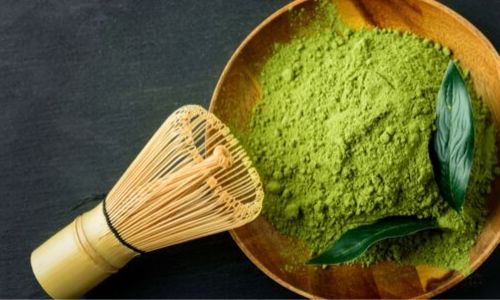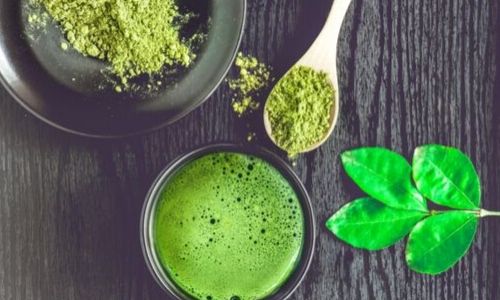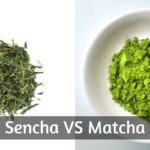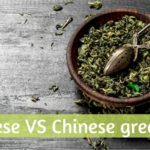The taste of Matcha is hard to describe, much like it would be hard to describe a good wine or coffee. Half the flavor is how it makes you feel, and the other half is kind of hard to pin-point.
So let's talk a little about how this wonderful green tea can taste so you have a better idea of what to expect on your first sip.
Table of Contents
So what does Matcha taste like ?
Matcha tastes like the best combination of flavors, with a smooth creamy feel that pairs with the vegetal notes very well. You can also describe Matcha with slight bitterness with a sweet aftertaste, buttery/nutty and a grassy undertone to everything.
This is due to the high chlorophyl content, which is present in nearly all plants. This is actually present in algae as well, and it's what gives them that savory, umami-like flavor.
This translates into Matcha as well, since the taste is also described as very powerful, flavorful - you can really taste the green in Macha, but it's not really like green tea.
If you got a high grade Matcha, like ceremonial grade, then you should feel a little creaminess or even buttery tone. This is a sign the tea leaves used for Matcha have been grown in the shade, and their flavor hasn't been 'dried' in the sun.
If you're ever had Milky Oolong then know that Matcha is a bit similar. Not as buttery in flavor, but definitely in the ballpark, only it will taste a little different since the drink will be thicker and the powdered leaves will grant a more vegetal taste.
So in short, Matcha is: grassy, creamy, tasty/umami, with a sweet aftertaste.
Always go for ceremonial grade Matcha
There are 3 Matcha grades, or quality levels. Which you get depends on your budget, the availability of the grade, and that in itself depends on the conditions on the farms where the Matcha is produced.
For example ceremonial grade Matcha, the highest grade, is available in small amounts because it requires the most skill to prepare and at times the crops only produce few leaves fit for ceremonial grade.
Very often you'll find the kitchen grade/culinary grade/cafe grade Matcha. This is the lowest, buts till good. It's a little bitter, but is often sweetened and is what you'll find in Matcha lattes, or baked goods, and in nearly any edible form of Matcha aside from the drink itself.
So the 3 grades are:
Culinary grade Matcha - lowest grade, can be a little bitter. The flavor is not as strong but you can definitely feel it if it's your first time drinking Matcha. Might not be vibrant green. Very common, fairly easy to find.
Premium grade - better than culinary grade, is only used for drinks. Not for lattes, but for simple, traditional Matcha shots. Isn't supposed to be bitter at all, has a creamier flavor than culinary grade. Should have a slightly sweet aftertaste.
Ceremonial grade - finest grade there is, and the hardest to come by and even buy. It's the most expensive grade, and is also the most flavorful. Creamy/buttery, sweet aftertaste, very bright green and vegetal flavor.
Powder is bright green, and is much finer to the touch than other grades. When mixed into water produced a creamier drink than other grades.
If you're looking for the pure, unadulterated flavor of Matcha then ceremonial grade is the best to try and get. If you can't find it or it's too expensive, you can go with premium grade, just try not to buy culinary grade.
Otherwise it'll be a less than stellar flavor experience, and if you're looking for a great cup of Matcha then culinary grade isn't the one.
Is Matcha sweet or bitter or savory ?
Exactly which way your Matcha leans - sweet, bitter, savory, or salty depends on the tea grade, the tea master who prepared it, and actually the temperature of the water as well.
So for example, sweet-ish Matcha is always ceremonial grade. It should have no bitterness at all, and you should only feel the creaminess and sweet aftertaste of Matcha.
Bitter Matcha is often a result of culinary grade Matcha, and will often need a little sweetener. You're changing the final flavor, but in some cases this is necessary.
Savory Matcha is also a sign of a good Matcha, but it can be both premium and ceremonial grade. It should be nearly salty, but not truly salty. Instead it should have the tea powder's intense flavor, that makes it just so flavorful.
The temperature of the water used and the skill of the one preparing the Matcha is also an important factor in how your Matcha ends up tasting.
Cold brewed Matcha is sweeter than warm brewed
As a general rule, cold brewed anything - be it coffee or tea - is going to have nearly no bitterness or acidity. So making cold brewed Matcha will result in a sweeter, lighter Matcha flavor.
It won't be as astringent or strong as hot Matcha, but it's definitely going to be more delicate and sweet, and yes creamy/buttery as well.
If you prepare hot Matcha, as is the traditional way of making a cup of Matcha then you may get some bitterness if preparing it poorly. After all, any tea will go bitter if you use water too hot or brew it for too long, and Matcha is no exception.
But as hot Matcha the flavors will be more pronounced. The sweetness at the end, the buttery/creamy notes will all be more prominent.
As for the skill of the person making Matcha, it's really something you learn over the years. Just how much to mix the drink for a great crema, and how much Matcha powder to use for 2 oz/66 ml of water, even the temperature of the water itself.
Matcha is an acquired taste
Getting used to Matcha is a bit of a feat. Even if you brew it in the best way possible, if you're used to very sweet drinks or processed foods then Matcha is going to be hard to swallow at first.
Much like black coffee, or pure green tea, Matcha is not a flavor that's very similar to others so it will taste foreign and strange at first.
In some cases and for some people it might even taste 'wrong', compared to what they usually know tea should taste like.
But the creamy, buttery flavor of a good Matcha will haunt you well enough to go for another sip. Then you'll start to feel past the grassy notes and into the more flavorful ones.
It'll take a few cups but once you do get used to Matcha it's smooth sailing. Your body will know and anticipate the grassy yet buttery notes, and will actually like it.
If you've ever had a Milky Oolong, you'll know what I mean. Matcha is not as milky or buttery, but it's pretty close.
Fixing the taste to your liking
If you can't get used to Matcha at all after a few cups and find no way to tolerate the flavor, then you have two options:
- give up, some things are simply not for some folks, no matter how much others praise those things.
- sweeten the Matcha, but lose a part of its health benefits.
Sweetening Matcha is going to ruin some of the health benefits - specifically those related to the antioxidants in the tea - but it can be done.
I recommend adding honey or Agave nectar instead of actual sugar. This way you're at least bringing less sweetness but some more nutrients into the body.
I do not recommend adding milk to Matcha to make it more tolerable. Aside from completely changing the flavor of the tea, it's not something most Matcha grades can handle.
There are Matcha lattes, yes, but those are as far away from a real cup of Matcha as is Matcha ice cream.
Storing your Matcha properly preserves the flavor
Your Matcha might taste funny if it's poorly stored. Matcha is a short-ish shelf life to begin with, but if you don't keep it well enough it's not going to be very good after a while.
Storing your Matcha properly means keeping it in a airtight, and watertight jar. Get a good lid, and make sure there is as little extra air in the jar as possible.
Keep the jar away from heat, humidity, and direct sunlight. Get an opaque one if possible.
And try to get a creamic or glass one, or at least coated with ceramic since metal can change the flavor in time.
Your Matcha powder should be bright green, and will darken or lose its brightness in time,a s it starts to oxidize.
If it's starting to turn a little yellow there's no point in brewing it.
Fishy Matcha is a sign it's gone bad
If you get Matcha that's somehow fishy, stop using it. By fishy I mean actually fish-flavored, since it's a sign the Matcha powder has no only oxidized but also picked up flavors from the surrounding area and is no longer any good.
Conclusion
Matcha tea is a very flavorful cup of tea, especially if prepared the right way. You're going to find it challenging at first, both to prepare and to drink it if you've never had something similar.
And most folks haven't.
Still, getting used to the flavor and managing to find the beautiful creamy and grassy notes in a good cup of Matcha can be very rewarding in its own way.
If you want to know more about coffee or tea, feel free to check the related articles below. Who knows what else you might find ?

